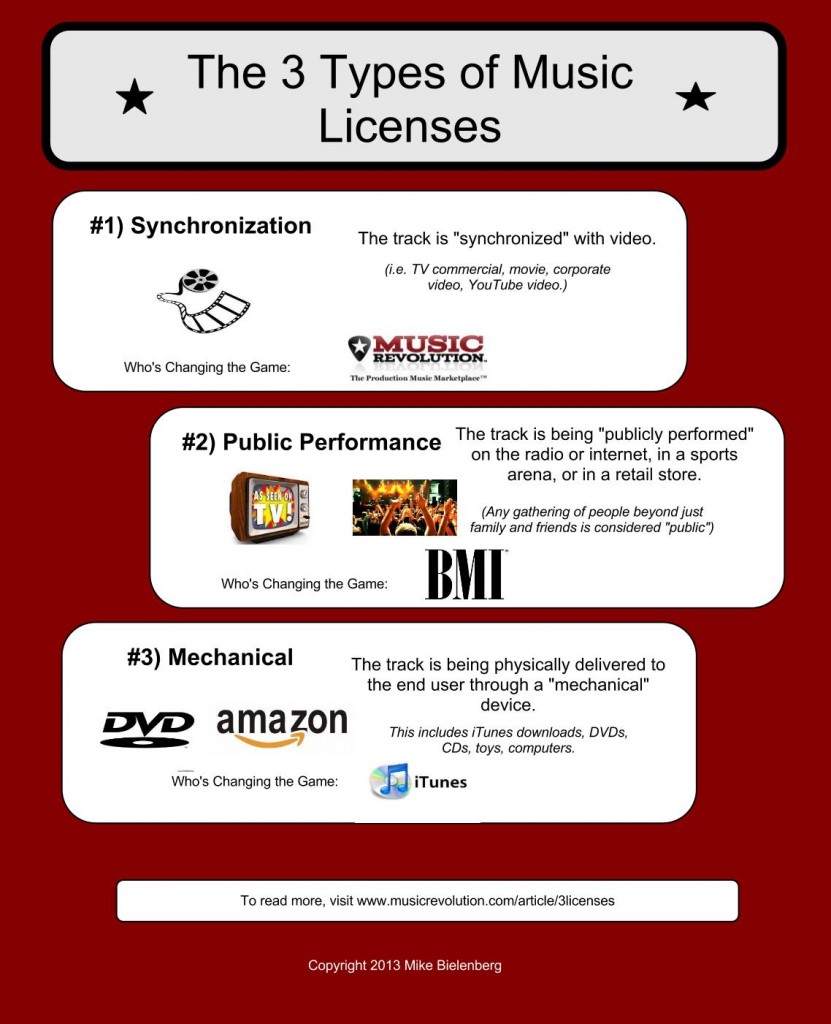There are three basic ways that music is used by individuals and businesses. For each of those three ways, there is a specific type of license. (synchronization, public performance and mechanical respectively). It’s important for both music buyers AND the music sellers to have a basic understanding of these three licenses. This infographic is absolutely free to download and use. Enjoy.
How These Licenses Have Changed
Synchronization
Due to a decrease in music production costs, the proliferation of indie music online and major labels no longer playing middle-man, we’ve generally seen sync fees trend downward. But don’t underestimate how much creative teams will pay once they’ve found the perfect song. And don’t underestimate how much companies will pay for legal peace of mind.
Synchronization is the least standardized of the three types of music licenses therefore prices vary wildly. A placement fee to an unknown artist to use their song in a major network TV show can pay as low as $500.00, yet the Rolling Stones received $10 million for the rights to use “Start Me Up” in Microsoft’s Windows ad campaign.
Performance
We view this as a growth area for music revenue…yes..growth. Performing rights organizations like ASCAP and BMI are deploying digital tracking services that scour the internet, watch TV, listen to the radio and even call businesses to see what on-hold music they’re playing….all in the name of making sure musicians get paid whenever their songs are publicly “performed”. Sound a bit like Skynet? Yes, but in this case it’s actually working in musicians’ favor. The three planets lining up here in a historically unprecedented way are 1) Unionized songwriters, 2) US copyright law and 3) Big Brother. In 2011, ASCAP grossed $985 million on behalf of their songwriting members. The cost to become a member of ASCAP? Absolutely free.
Mechanical
This type of license was severely disrupted when people started downloading music. There’s far less money on the table now that fans don’t have to buy a $15 album to hear just one song. Now they pay just $0.89. Of that $0.89, iTunes keeps $0.29. The remaining $0.71 gets split between the artist, the publisher, the label (if there is one) and in many cases a 3rd party uploading service like www.tunecore.com.
In the old world, the Harry Fox Agency operated a profoundly profitable monopoly that administered every royalty owed to every songwriter for every CD, album, or cassette tape ever made (pause to catch your breath on that one). Another interesting twist about mechanical royalties is that Congress is pretty hands-on about setting compulsory rates for this type of usage. That’s good for the emerging artist who wants to pay one low, standardized rate to record a smooth jazz version of the heavy metal classic “Home Sweet Home” then sell it on CD (and iTunes)…all without having to send complimentary whiskey to Motley Crue. Since digital downloads are considered a mechanical usage, iTunes is obviously the big influencer right now in terms of how Congress will adjust mechanical rates.
______________________________________________________________________________
Mike Bielenberg is a professional musician and co-founder of http://www.musicrevolution.com, a production music marketplace with over 22,000 tracks online where media producers, video producers, filmmakers, game developers, businesses and other music buyers can license high-
quality, affordable royalty-free music from an online community of musicians mbielenberg@musicrevolution.com.
![]()
